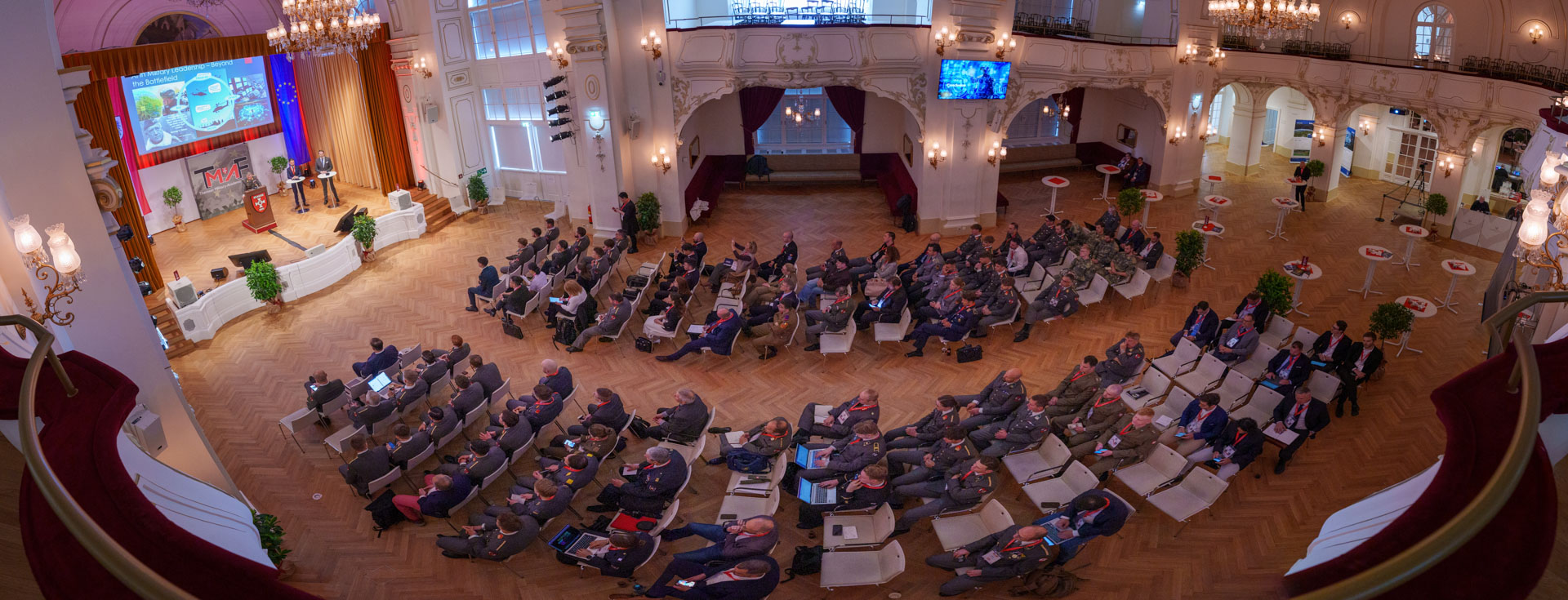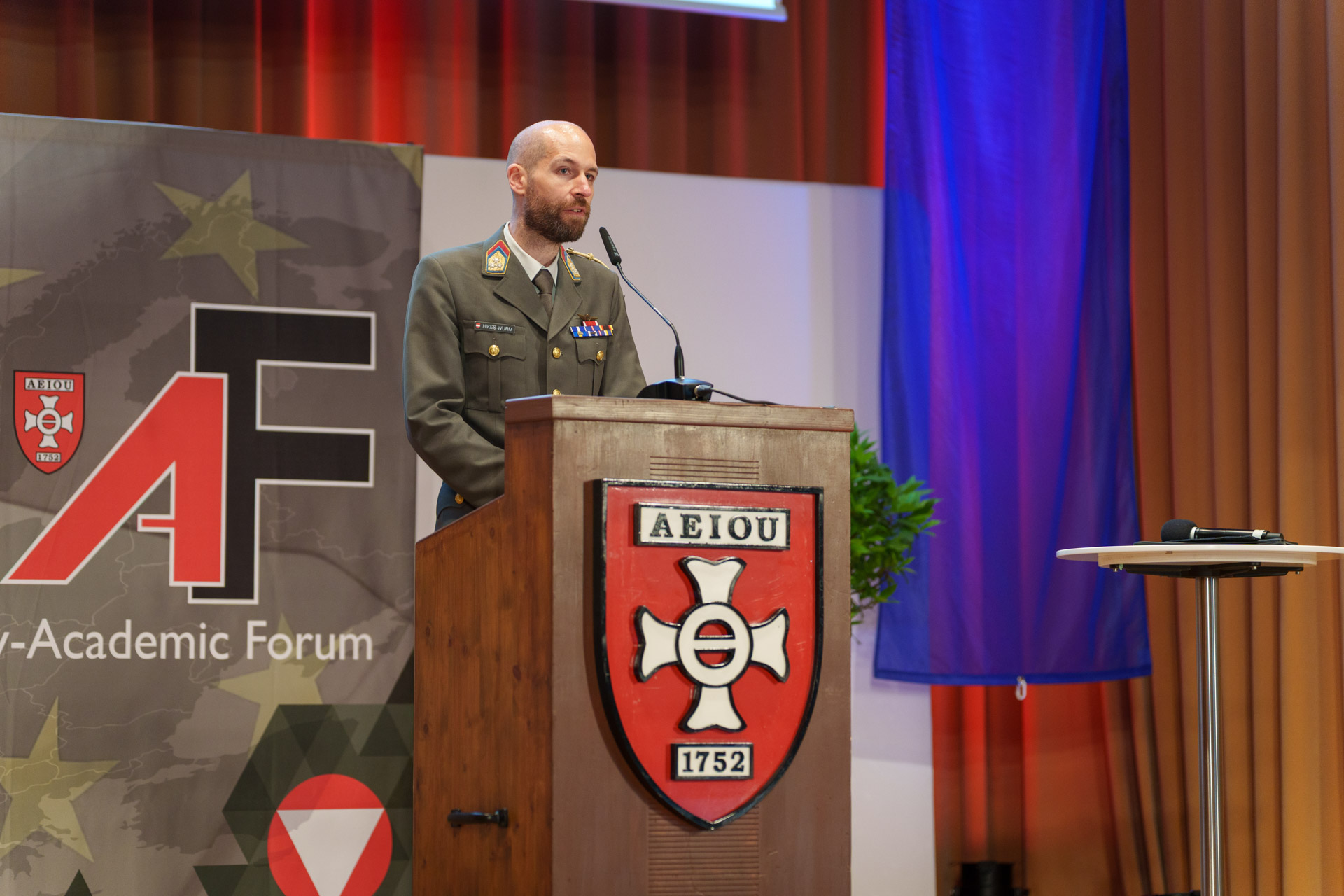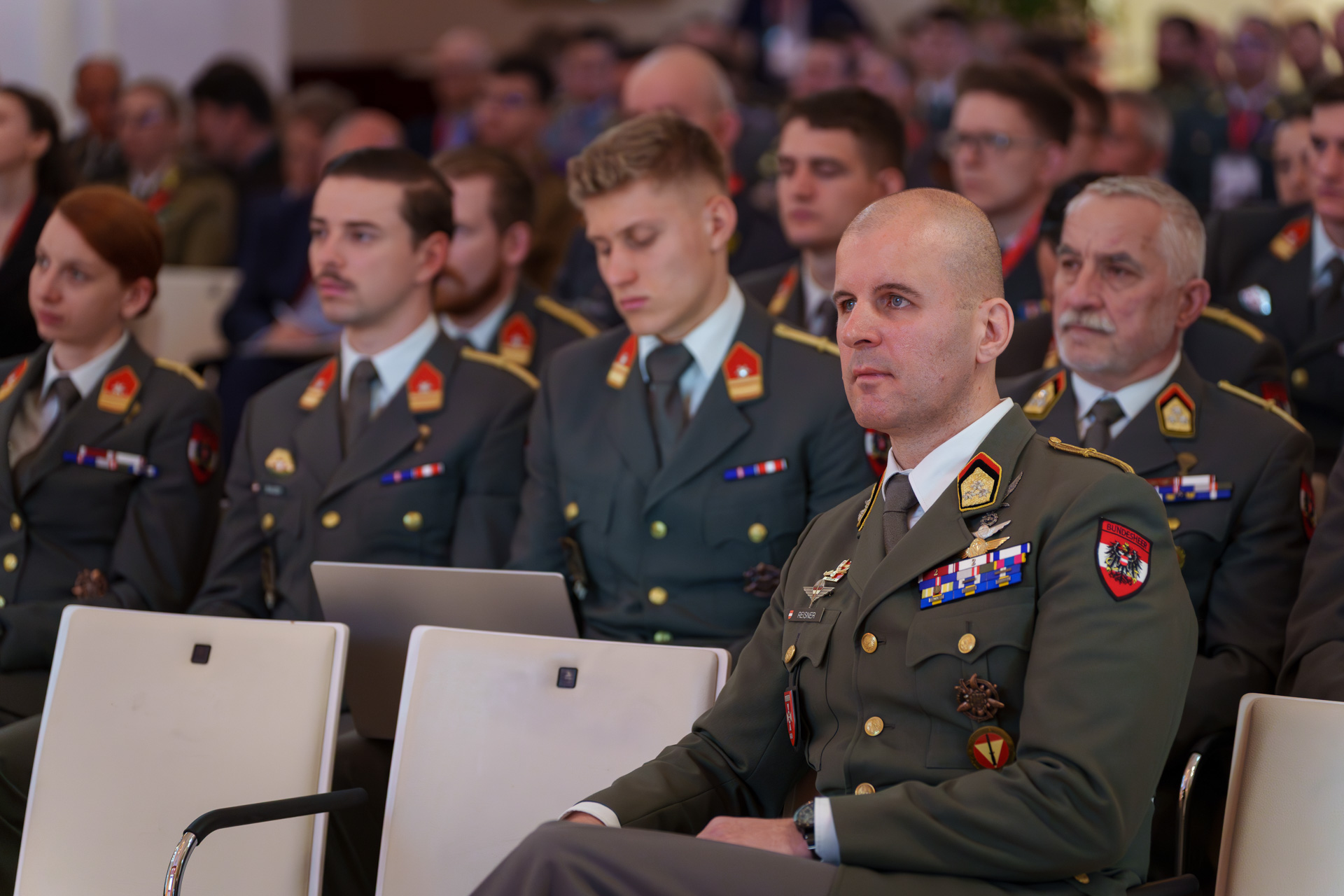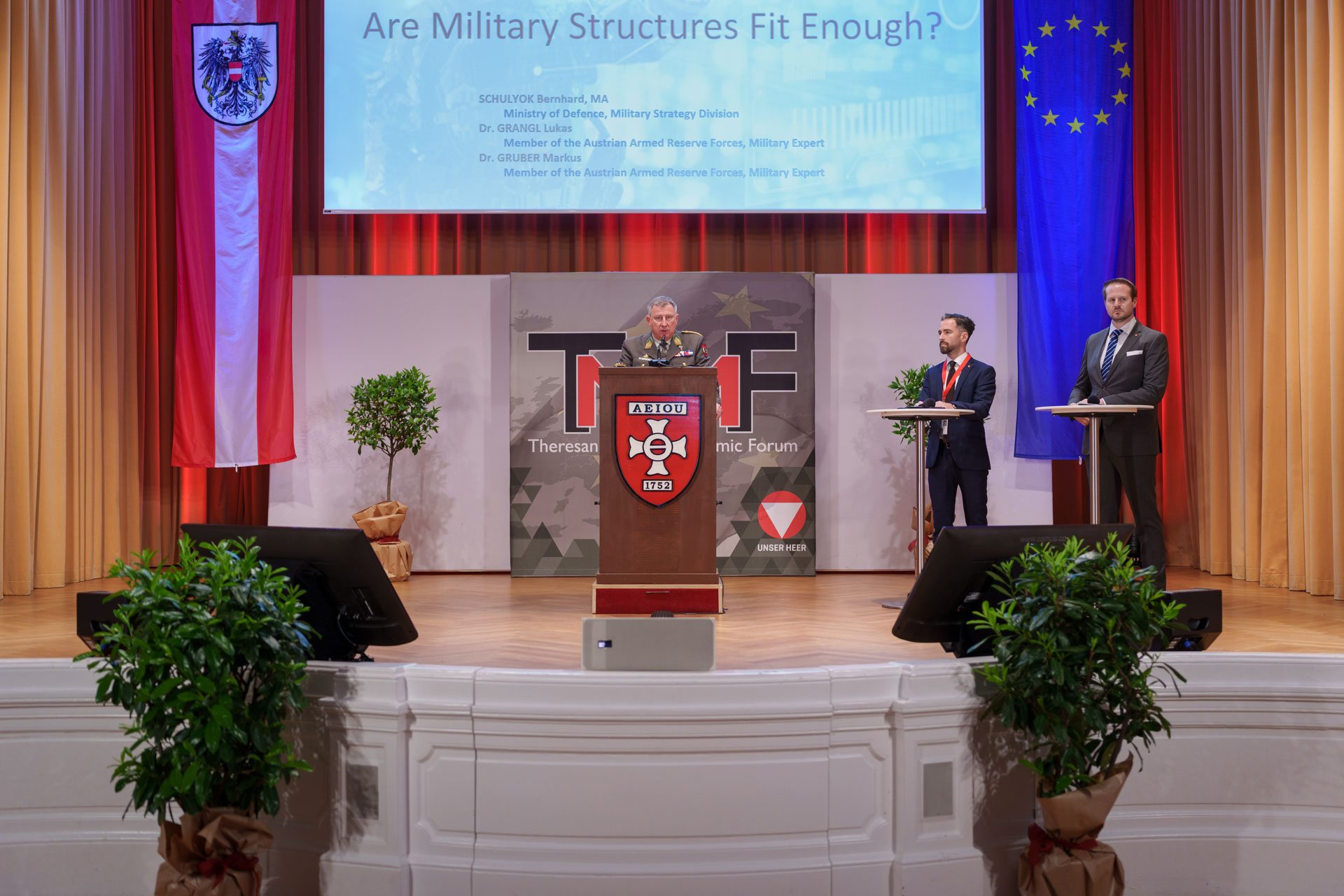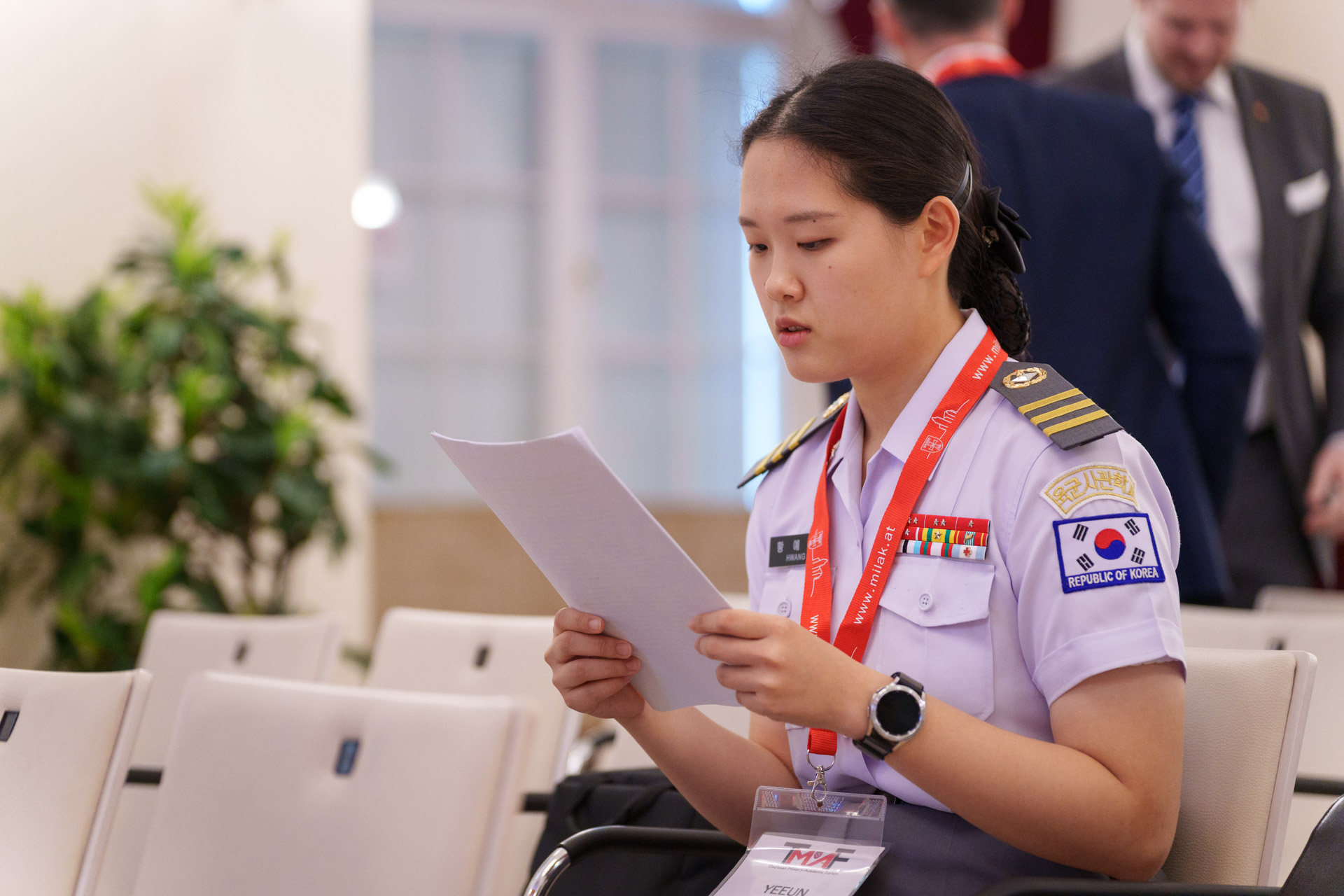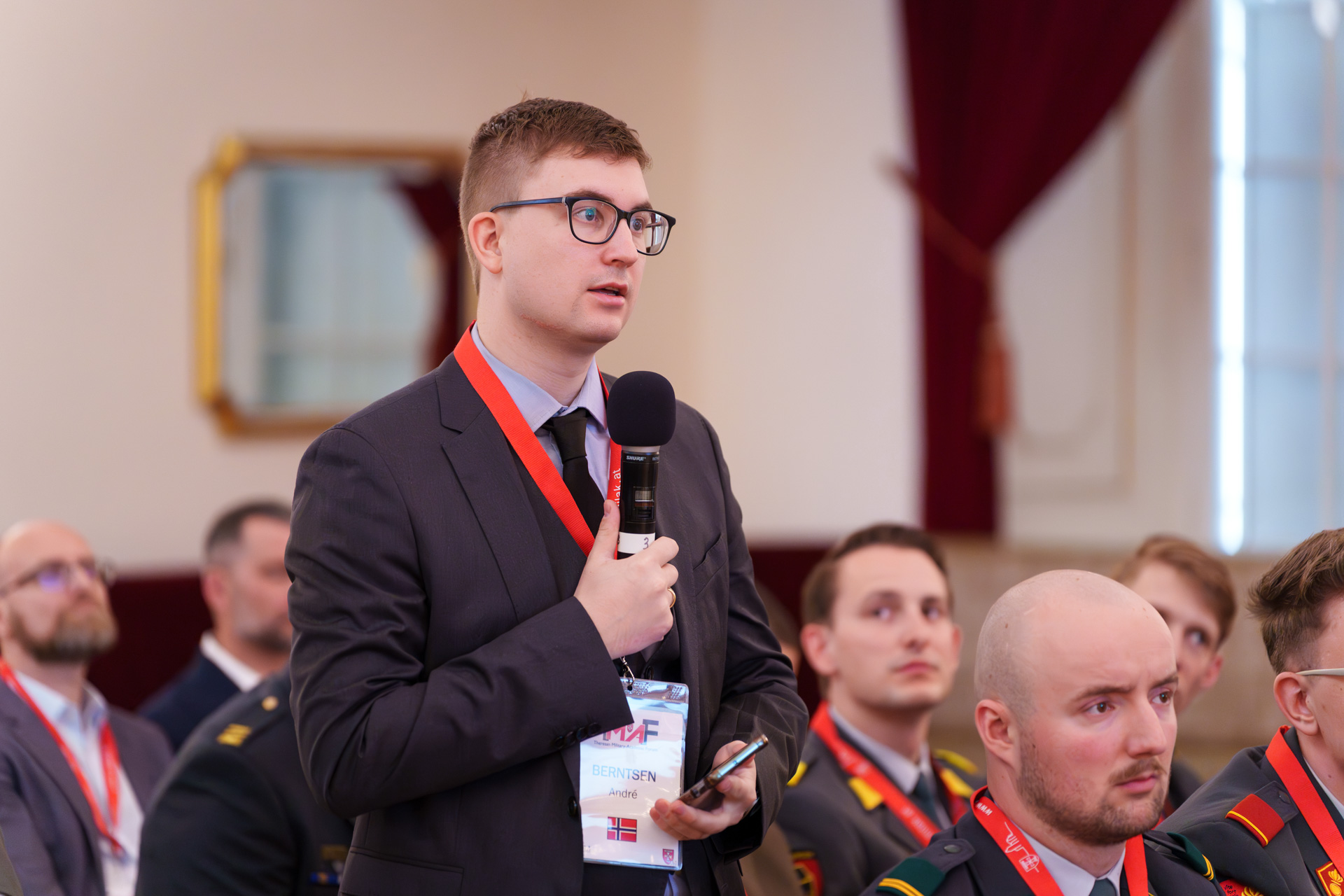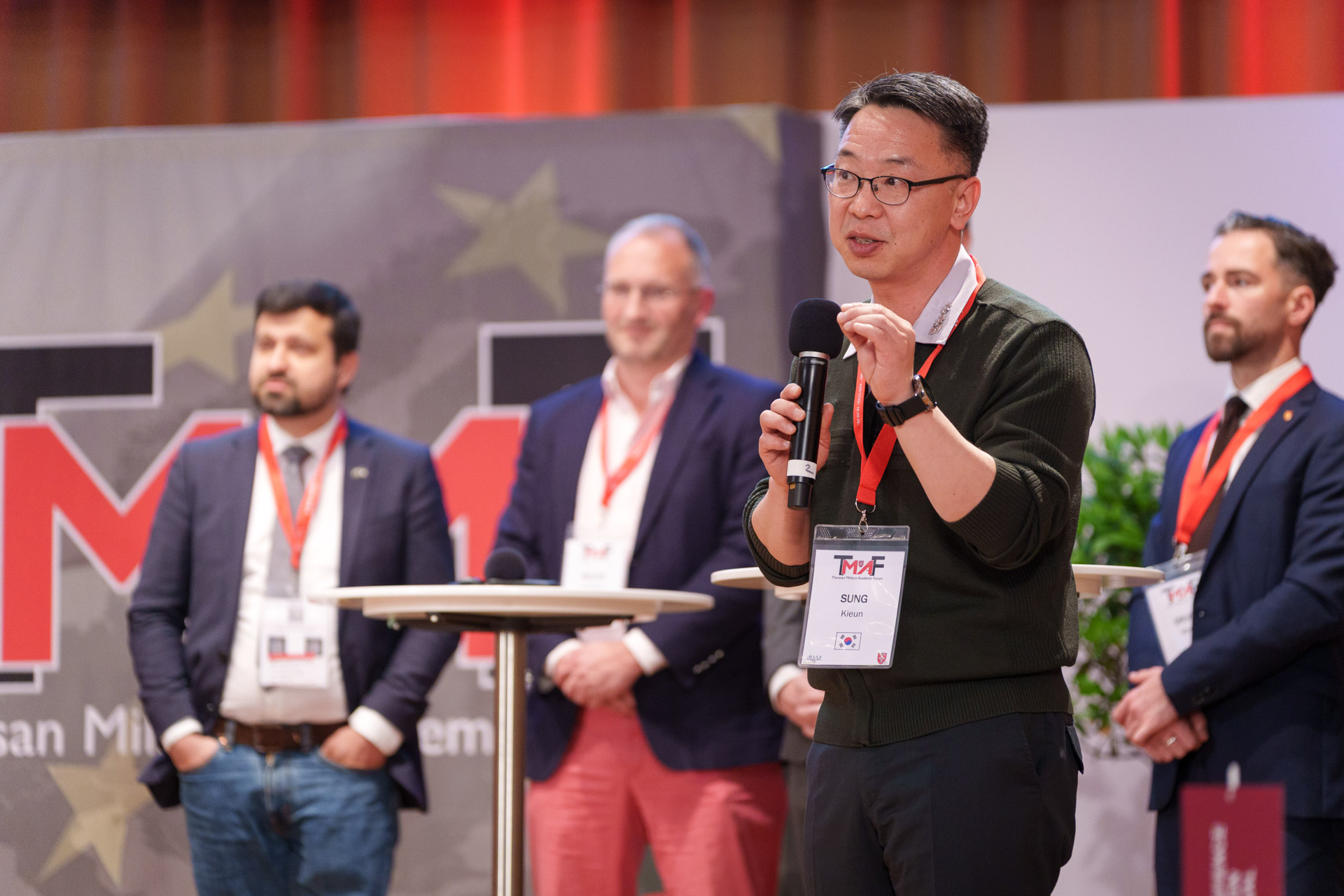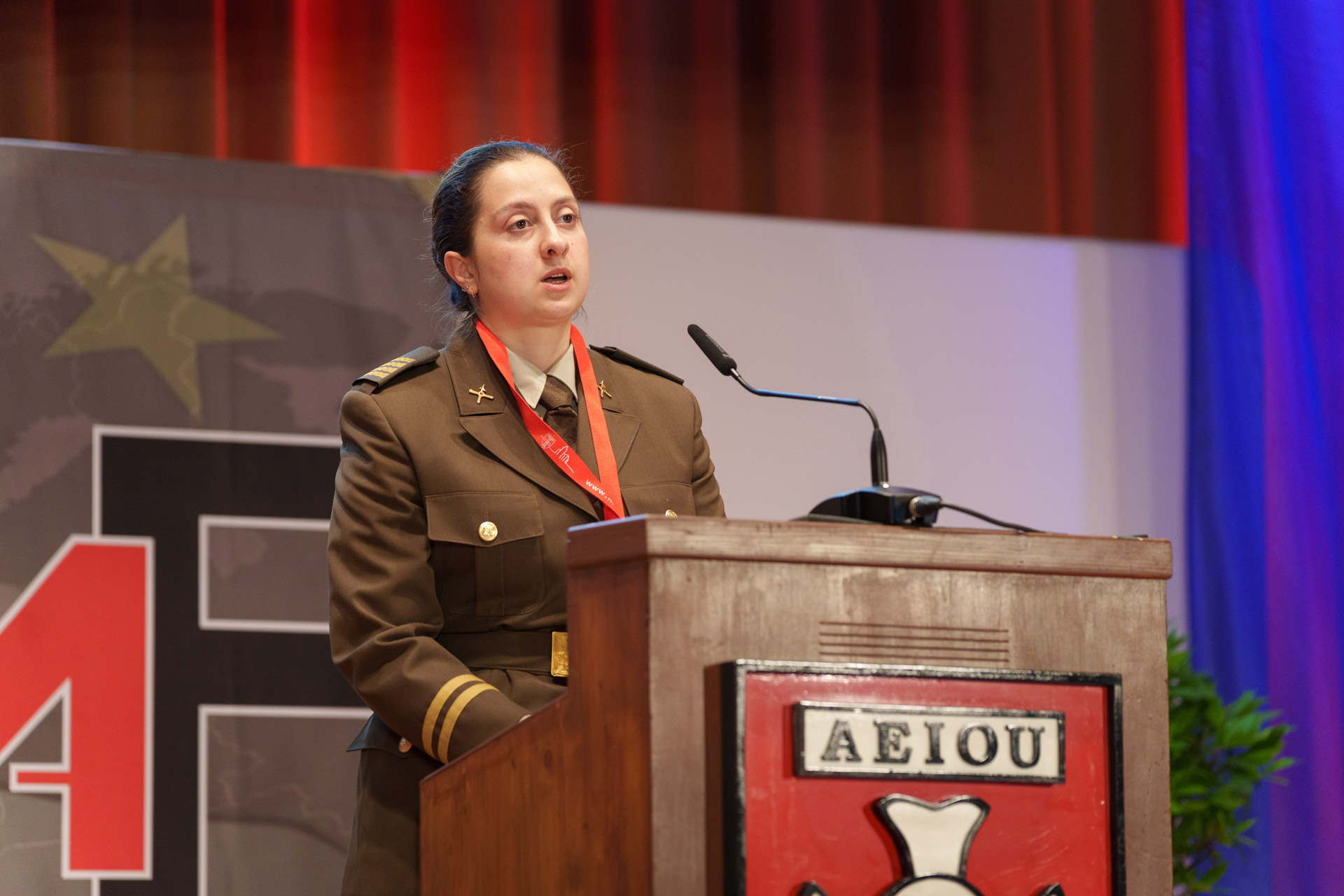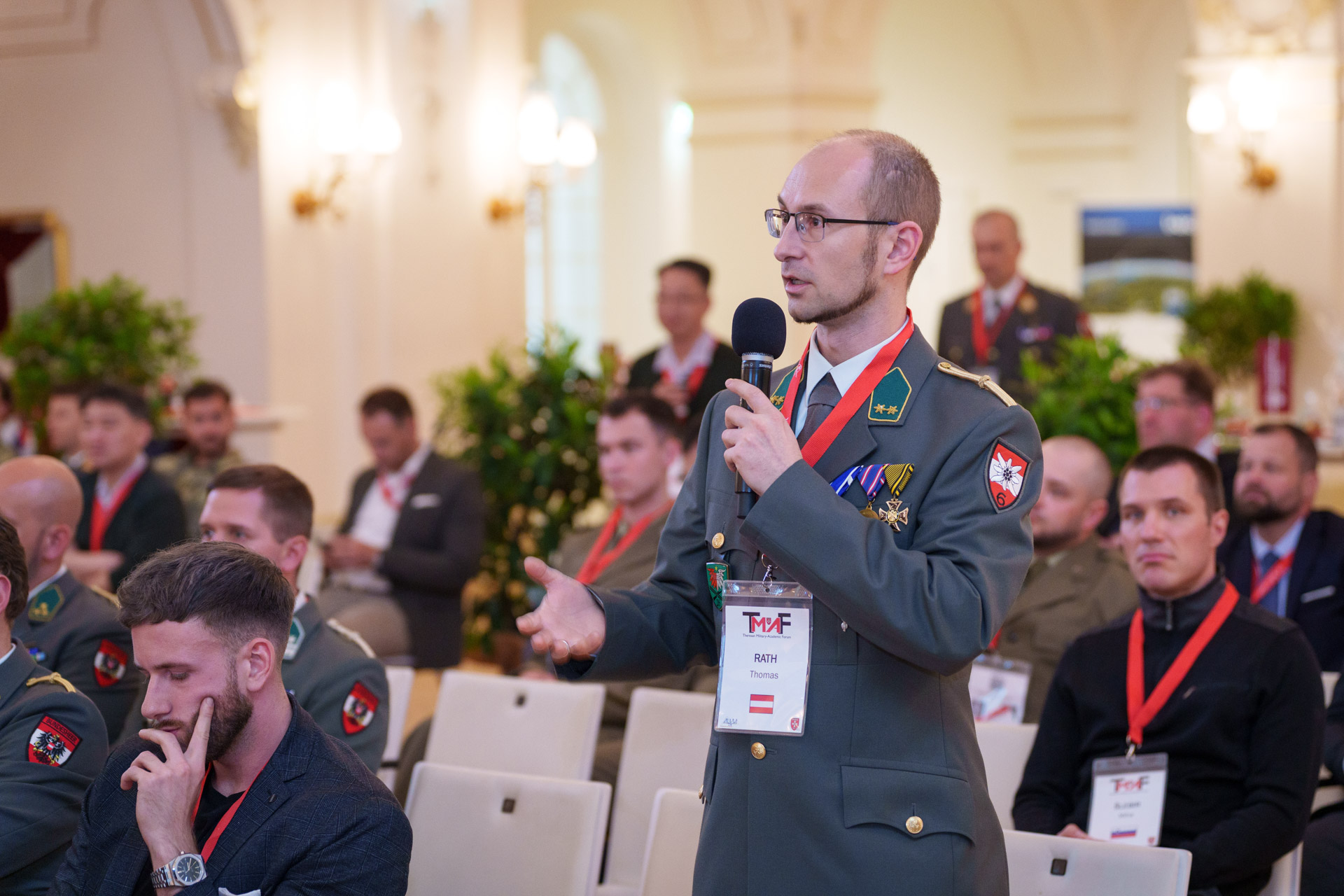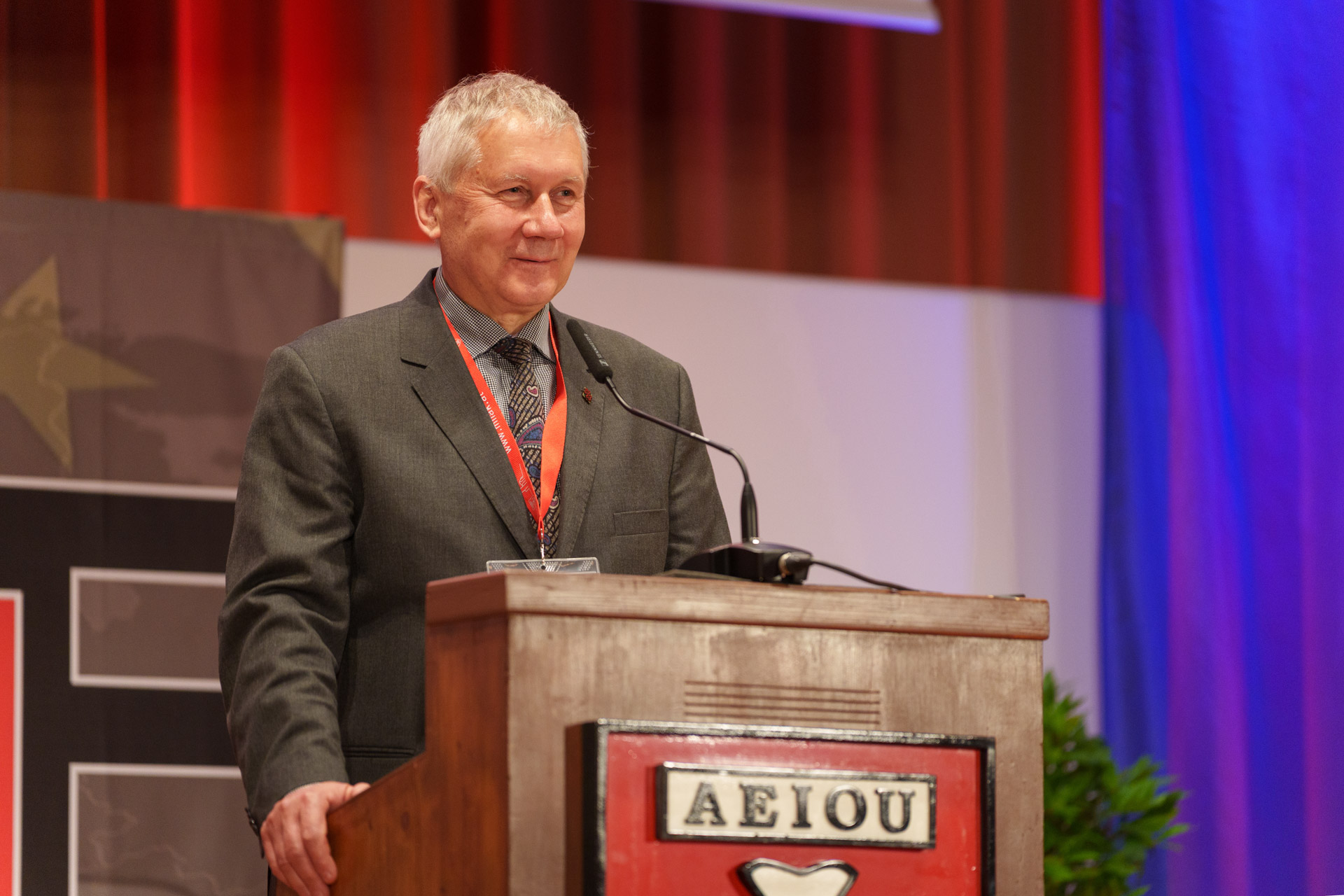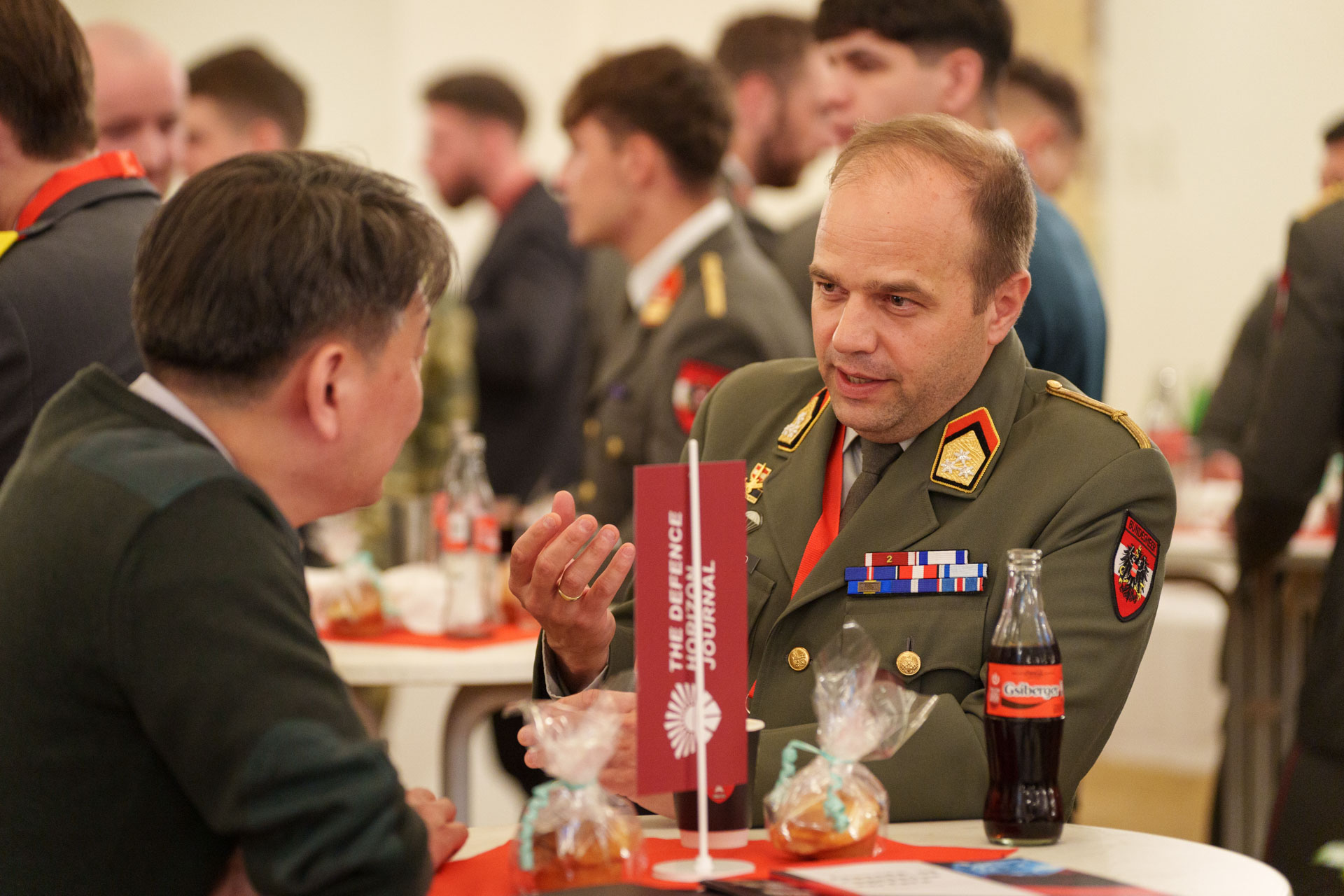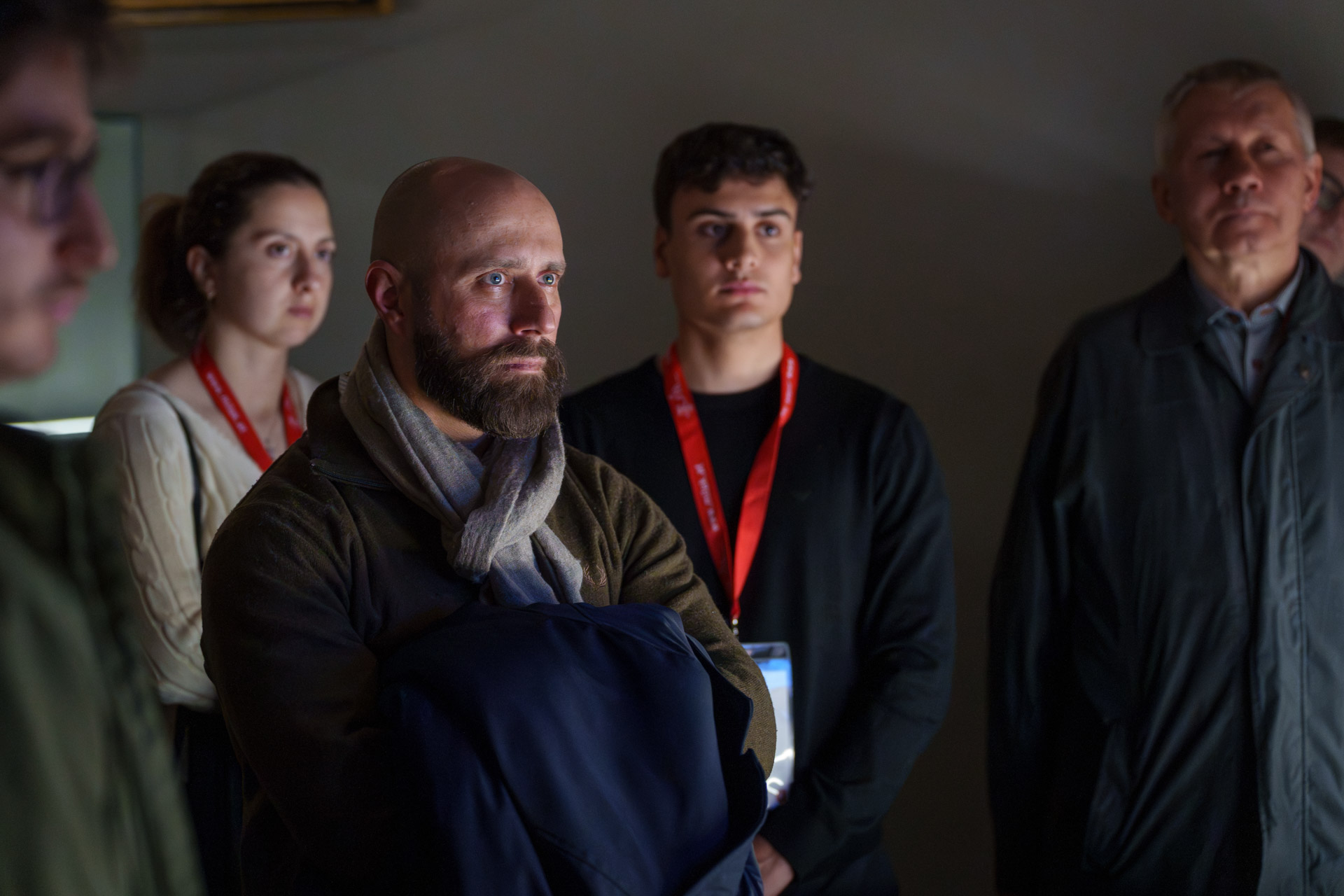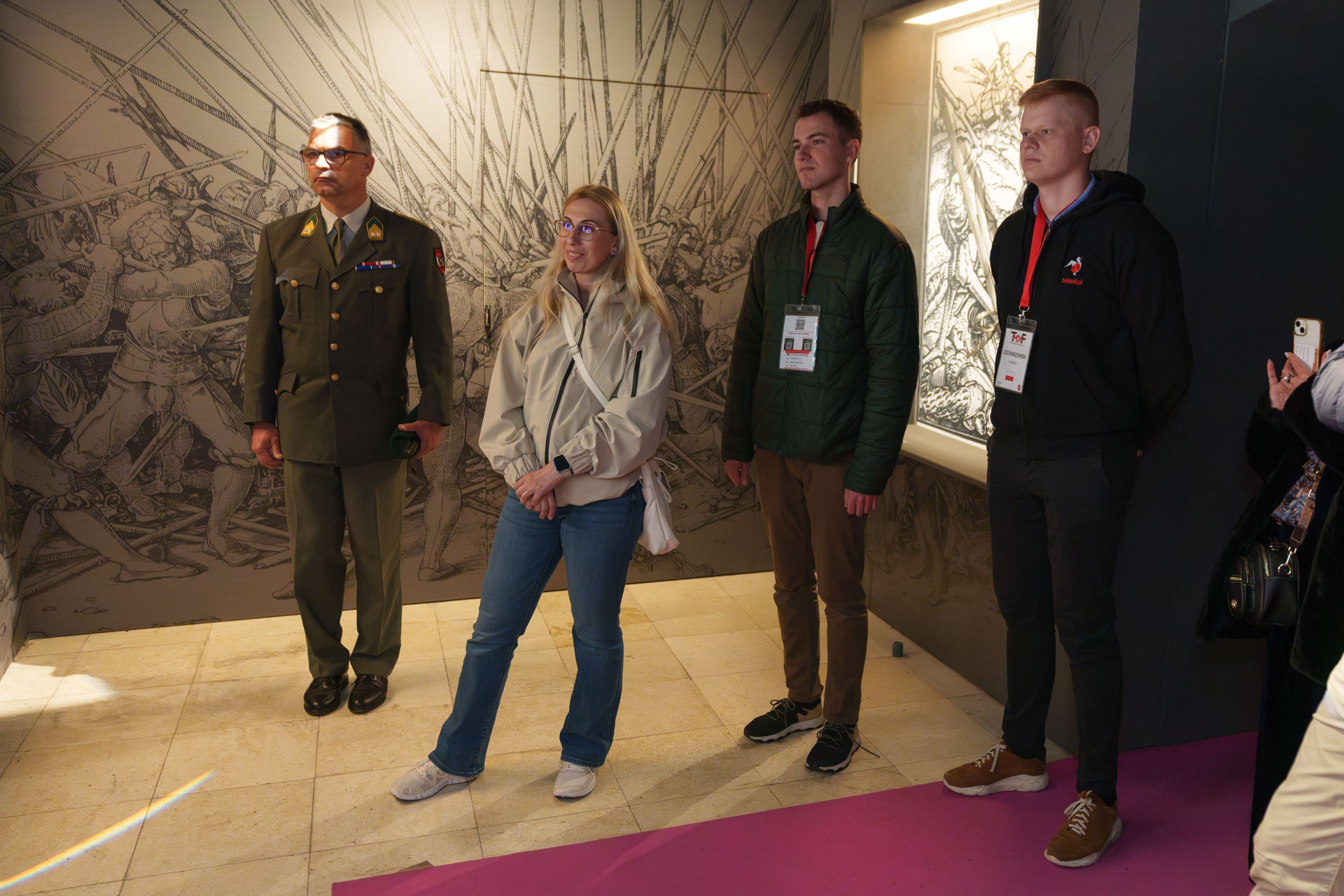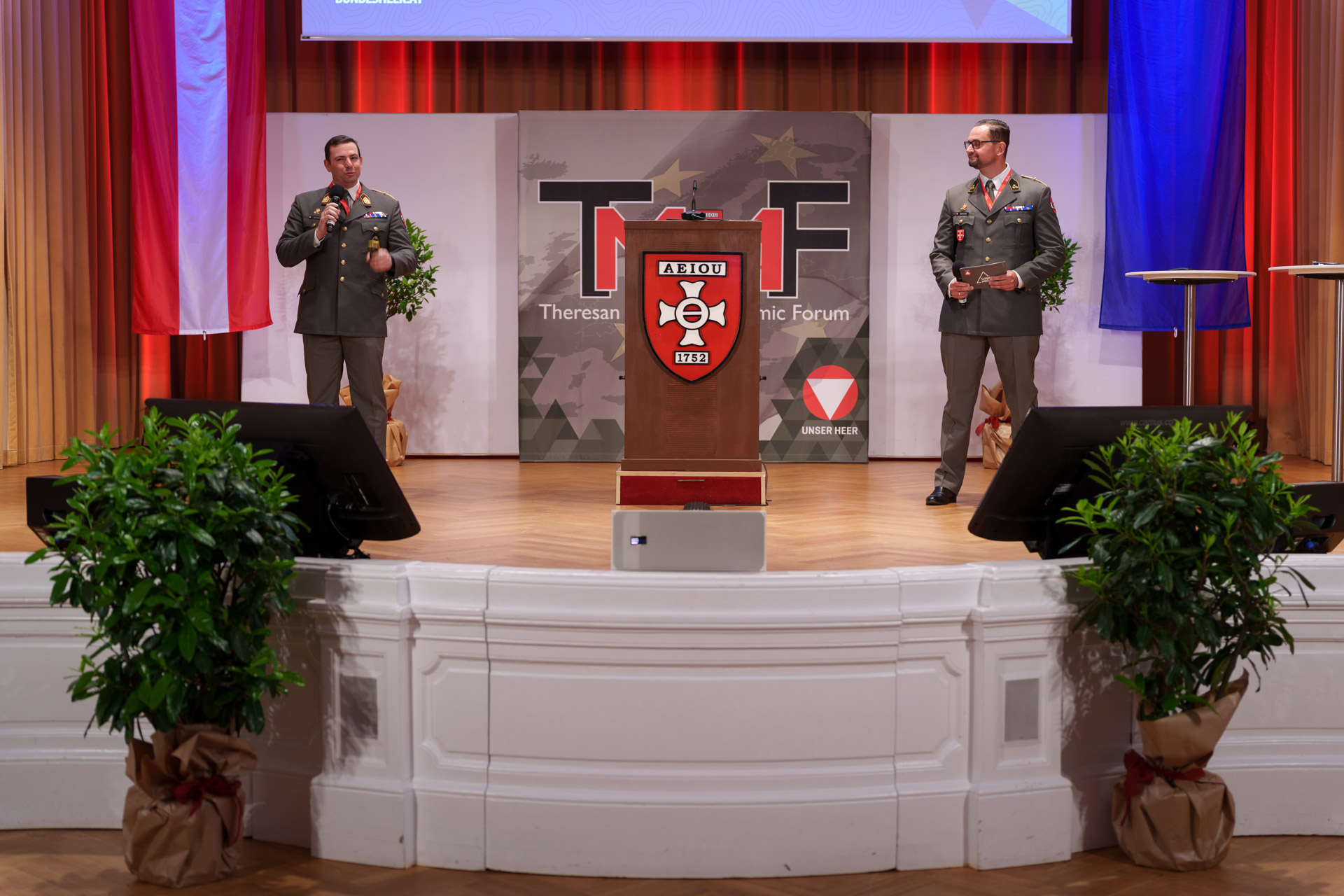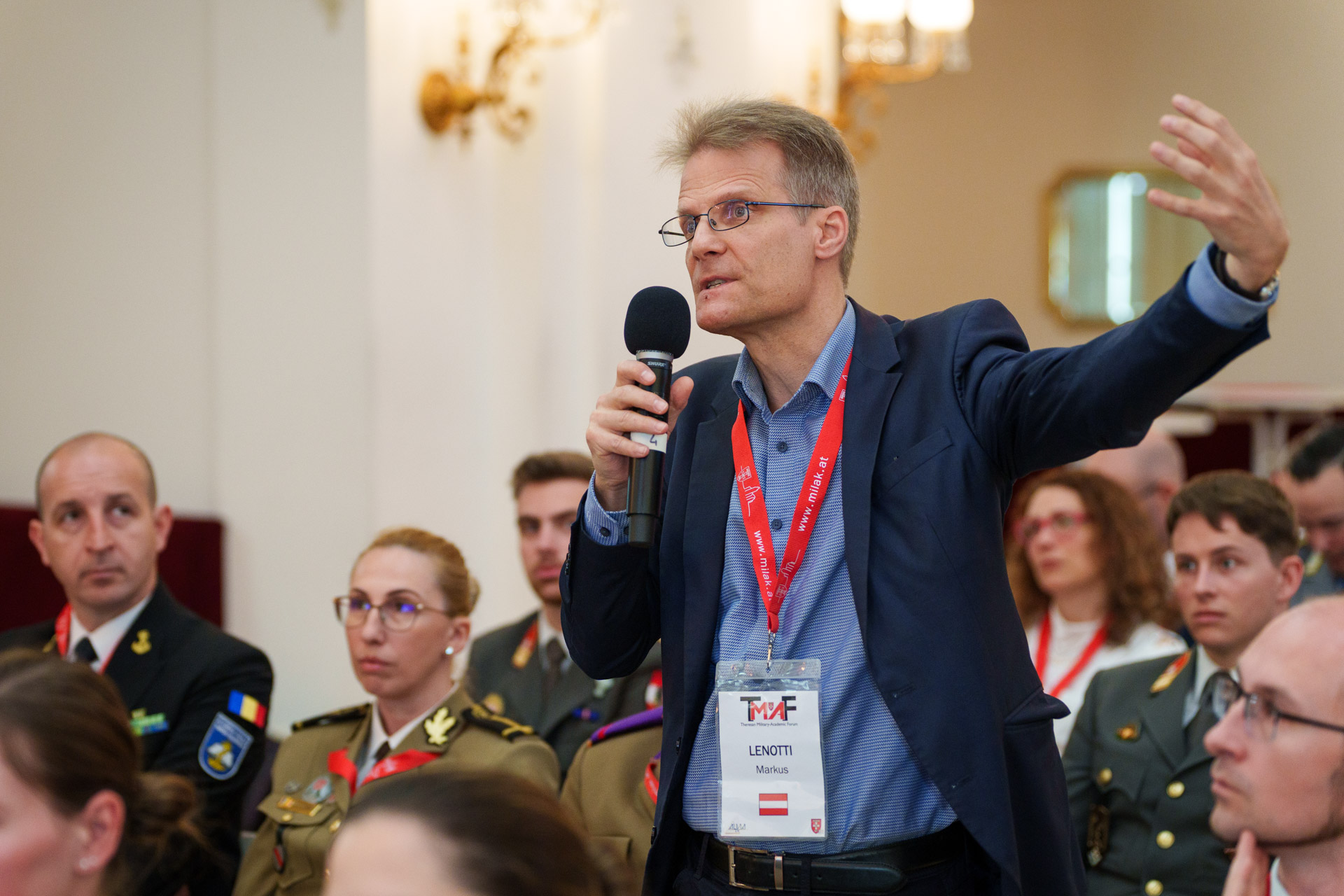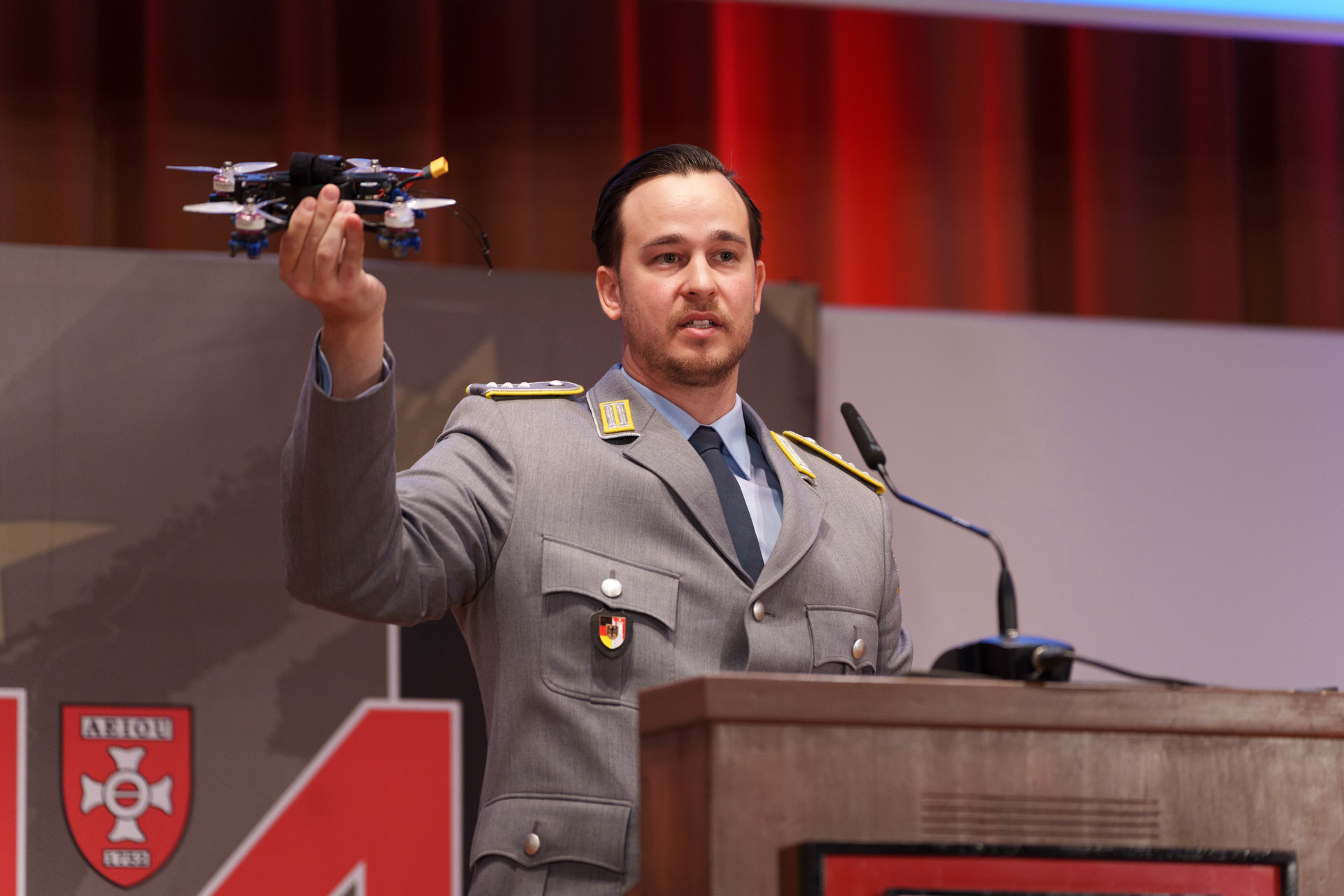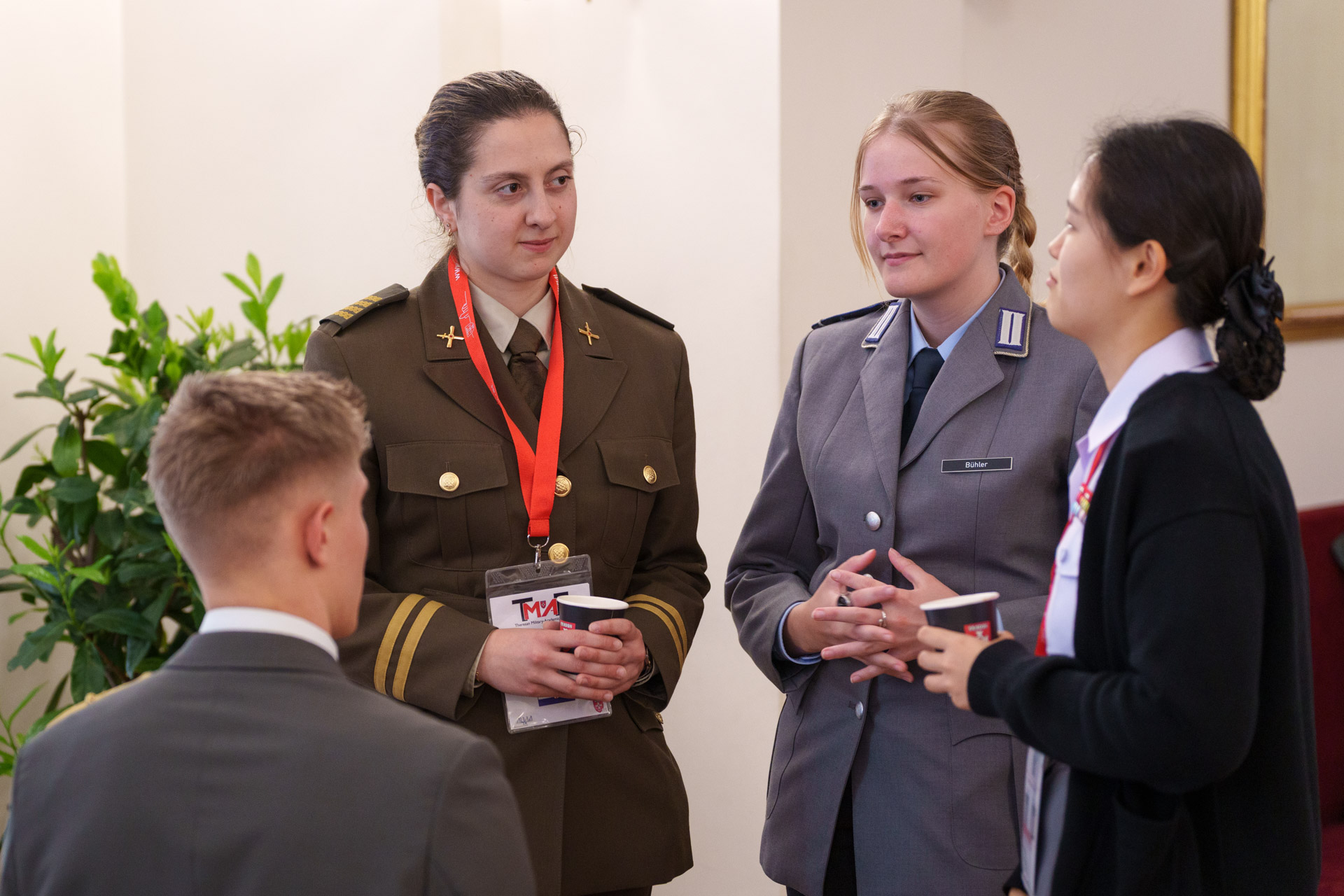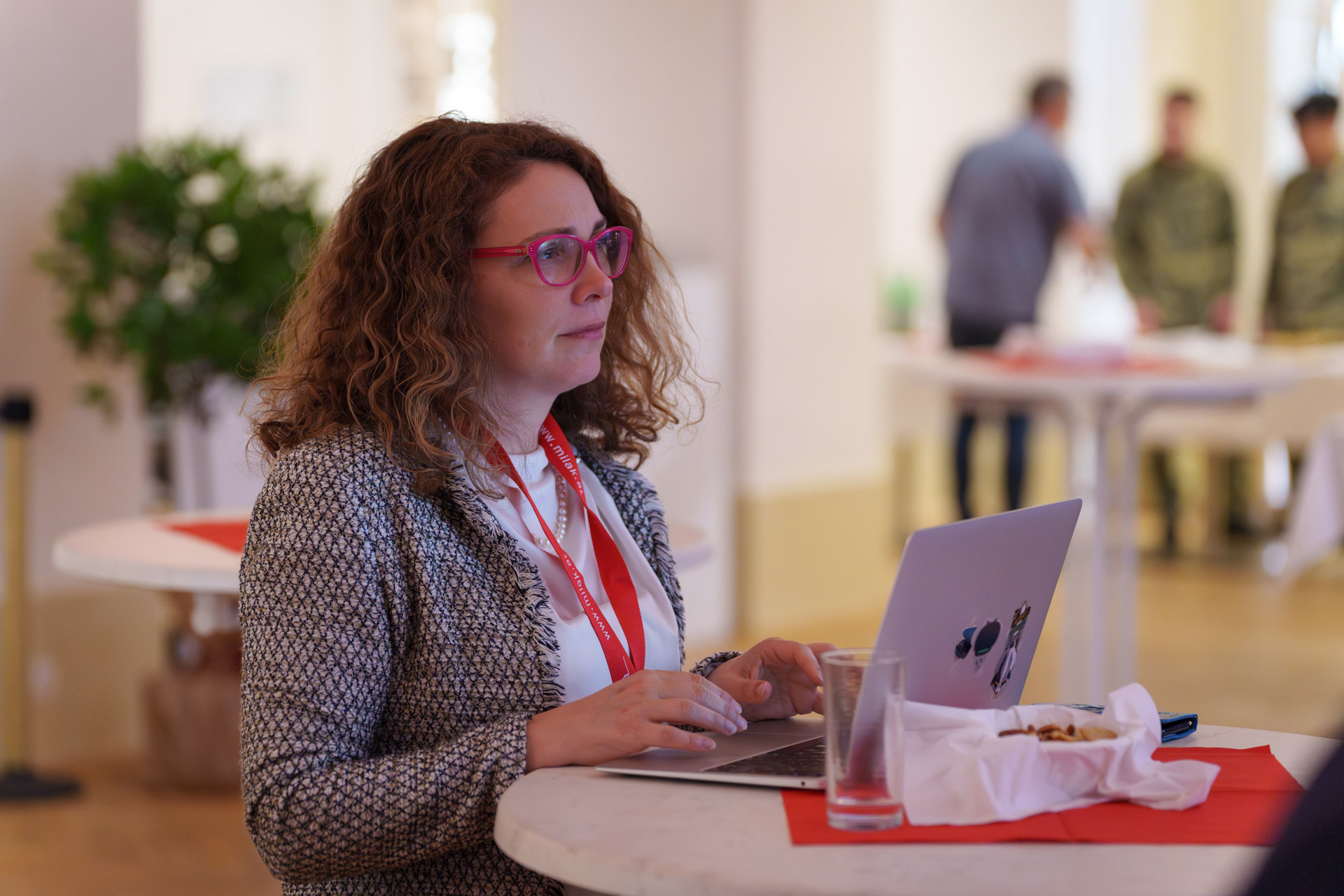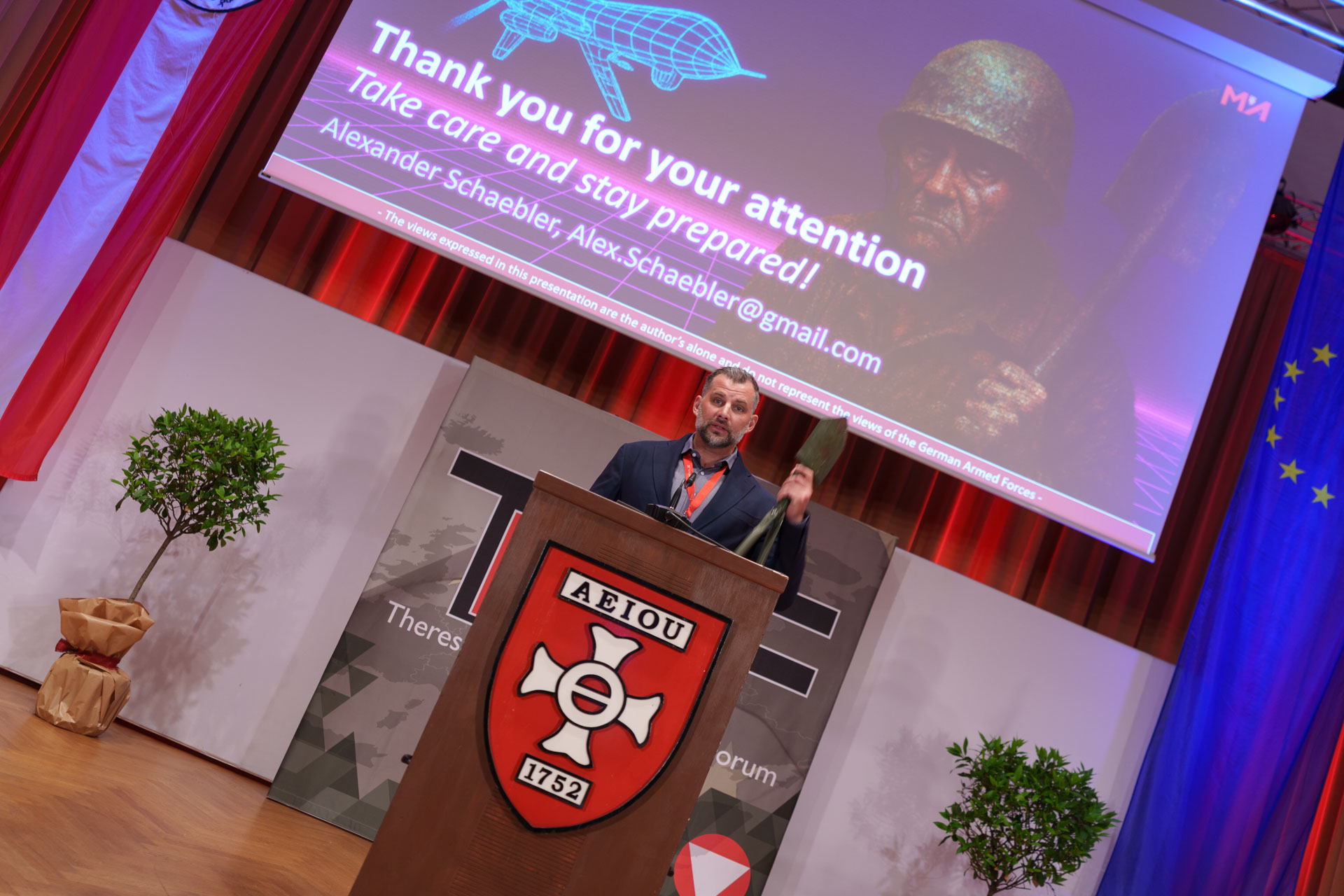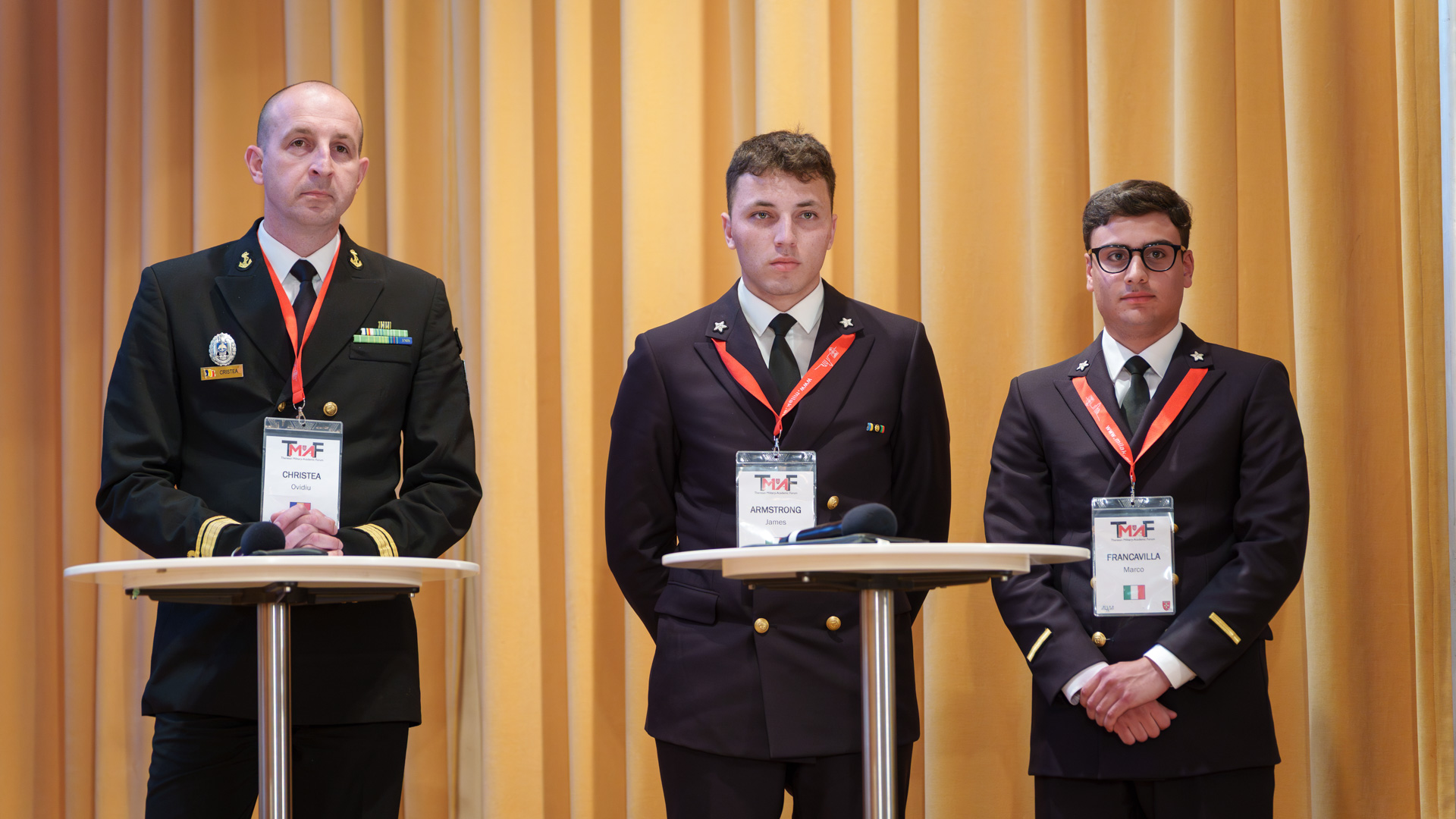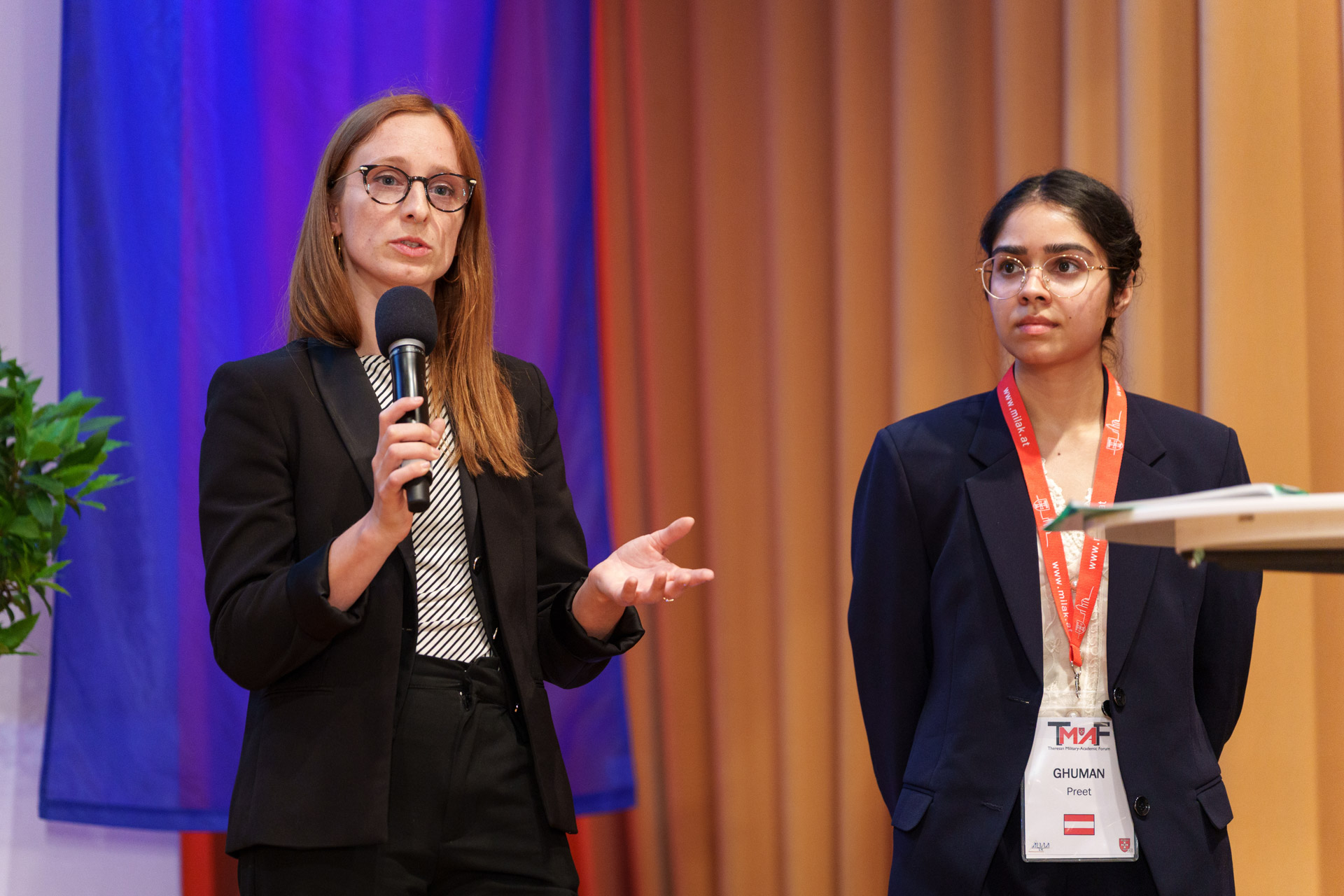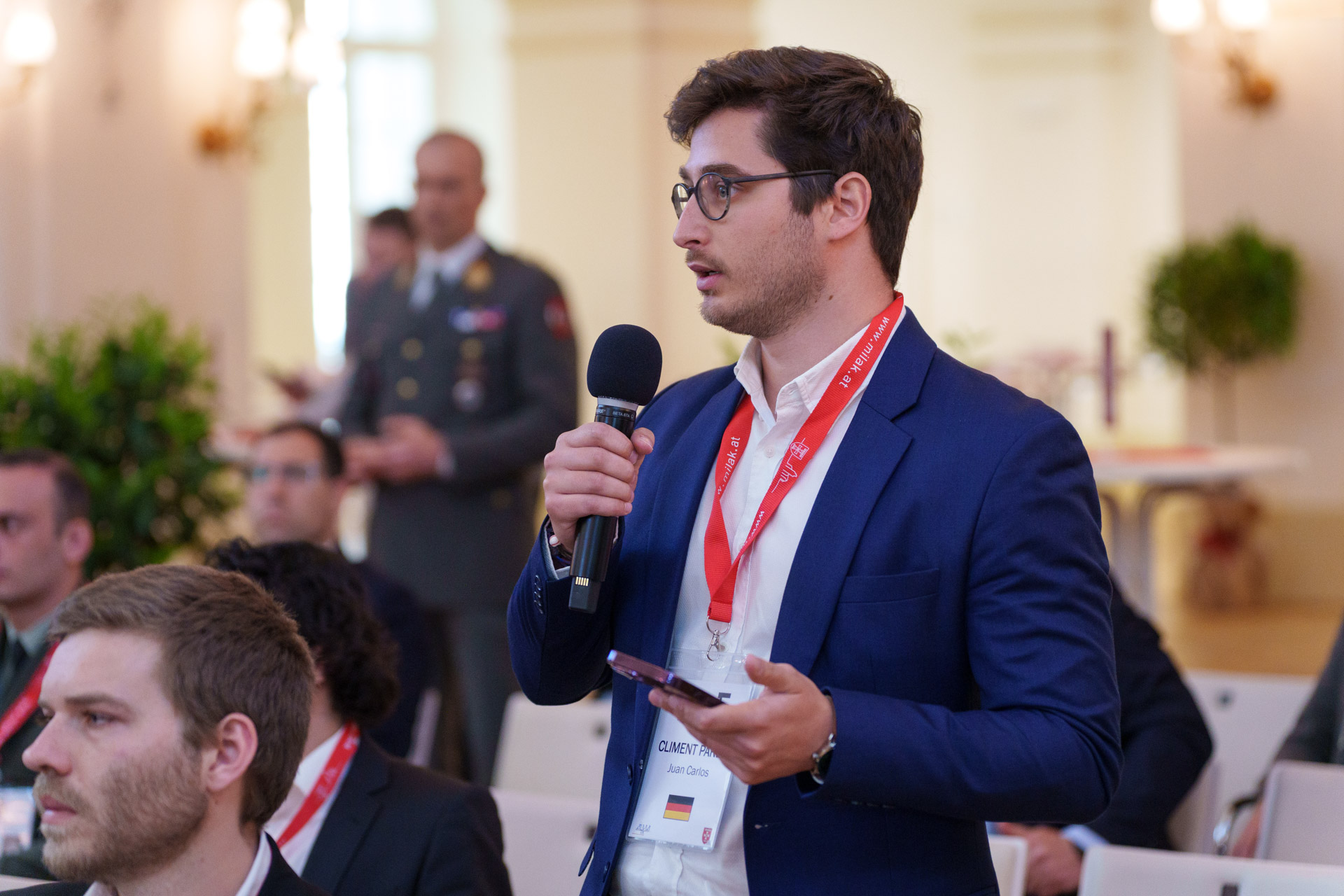TMAF 2025
"WarTech Nexus: Industrialising the Future of Autonomous Warfare"
The Theresan Military Academic Forum (TMAF) 2025, our annual scientific symposium, has been rescheduled from autumn to spring for organisational reasons. On 6th and 7th May 2025, 20 speakers from 14 countries representing military and civilian higher education institutions and industry gave presentations on current and future autonomous warfare. Digitalisation, automation and autonomisation have profoundly changed modern warfare. Artificial Intelligence and Machine Learning are just two examples of developments influencing current and future warfare and presenting new challenges for military strategists, the Western community of values and international legal norms, among others. We must therefore ask ourselves: ‘Is the global West losing its edge in warfare?’
Call for Papers
Experts and scientists were invited to participate in the Call for Papers in autumn last year. The scientific committee evaluated the 32 submitted abstracts and drew up a programme featuring the selected speakers.
The response to the call for papers was very impressive. Unlike last year, this year's TMAF was shortened and held exclusively in English. The symposium programme followed the usual sequence of two to three thematically related presentations, followed by a vivid Q&A session. As in previous years, we cooperated with the scientific platform The Defence Horizon Journal.
Opening
On Tuesday, 6th May 2025, the Head of the Institute for Basic Officer Training at the Theresan Military Academy (TMA), Colonel Dr. Markus Reisner, PhD, opened the forum and welcomed the international participants. This was followed by a speech by the Head of the University of Applied Military Sciences Board, Dr. Michael König.
Colonel Daniel Hikes-Wurm, from the Department of Defence Policy and Strategy at the Austrian Federal Ministry of Defence (MoD), delivered the keynote speech, setting the thematic tone for the event. Colonel Matthias Wasinger, PhD, moderated the event once again this year. A brass ensemble from the Guard Music Corps accompanied the opening ceremony.
Are the military structures fit enough?
Colonel Bernhard Schulyok from the Austrian MoD and the two reserve experts Dr. Lukas Grangl and Dr. Markus Gruber introduced the first topic. They attempted to answer the question of whether the available military structures are fit for modern warfare, such as that currently being waged in Ukraine and the Gaza Strip. The three speakers believe that only by continuously adopting the latest technologies and adapting the respective organisational structures and tactics accordingly can the operational readiness of the troops be achieved and maintained, and strategic superiority preserved.
Colonel Insoo Kim together with Lieutenant Colonel Kieun Sung and Cadet Yeeun Hwang from the Military Academy in South Korea then presented the results of a study that examined the relationship between the degree of automation and the combat effectiveness of military units. Demographic changes in South Korea are forcing the use of unmanned combat systems (UCS), which are expected to be more operationally efficient than soldiers. On the other hand, the availability of considerable human resources required for maintenance and repair limits the effectiveness of UCS.
The first block of topics was concluded by Dr. Wolfgang Müller from the German Institute for Defence and Strategic Studies (GIDS), together with Dr. Sergej Sumlenny from drone manufacturer United Unmanned Systems LLC. Both call for an adjustment of the defence industry's strategies, which are often still based on traditional manufacturing ideas. The massive deployment of autonomous and unmanned weapon systems requires new mass production methods that exist but are not yet used in the defence industry. After the three content-rich presentations, the speakers answered numerous questions from the audience before the group broke for a refreshing lunch break.
Historical lessons, current challenges and future implications
The afternoon session was opened by Andrè Berntsen, MPhil, from the Swiss Military Academy at ETH Zurich. He presented the results of a narrative analysis and case studies on the possible long-term effects of autonomous weapons on morale and the recruitment of future soldiers.
This was followed by a presentation by student Doris Dasović from the Croatian Defence Academy. Rapid technological developments in the fields of nanotechnology, artificial intelligence and three-dimensional additive manufacturing have led to unprecedented innovations in military applications, particularly in pyrotechnics and explosives. These new technologies offer immense advantages for military applications, but also raise ethical questions that require responsible handling. This section was also concluded with a discussion with the audience. After their presentations, the speakers answered questions from the participants. The presentations provided plenty of topics for discussion during the afternoon break.
Energy storage solutions and digital twins
Assoc. Prof. Dr. Gintaras Labutis from the Military Academy in Lithuania presented the connection between the constantly increasing demands on the efficiency, effectiveness and resilience of military operations and the associated rise in the military's energy requirements. Advanced energy storage solutions must be integrated in view of given the ever-growing energy requirements of soldiers, right through to the power supply of military bases and military platforms. Hybrid energy solutions, next-generation batteries and innovations in energy storage should improve the flexible and dynamic deployment of armed forces.
Michail Kefalakis, a PhD student at the Hellenic Army Academy, presented his research on improving battlefield observation and military decision-making using synthetically generated data. This data is used to create a realistic representation of the potential operational environment (‘digital twin’). Together with imitation learning of human decision-making processes, real conditions for training military leaders can then be simulated. This topic was also concluded with a discussion. The evening programme consisted of a group tour of the exhibition ‘From Imperial Residence to Officer Forge’ led by members of the TMA.
Training for tomorrow's conflicts
Captain (GS) Johannes Ginthör from TMA and Major (GS) Markus Schmid from the Austrian MoD opened the second day of the event. The two discussed how new technologies are changing the requirements for leadership and control systems as well as tactical planning. Based on this, training should be designed to ensure effective decision-making and combat readiness for the challenges of current and future conflicts.
They advocate a dual approach that combines institutional and individual preparation. By teaching the efficient use of available resources and through personal preparation by reading, learning, reflection and creative experimentation, the aim is to achieve thinking beyond conventional boundaries, mental agility, improvisation skills and adaptability.
Lieutenant Colonel (GS) Patrick Hofstetter, PhD, from the Swiss Military Academy at ETH Zurich, spoke about the changes in military leadership due to the advancing integration of artificial intelligence (AI). He believes that AI influences structures and doctrines and the philosophy of ‘mission tactics’ practised in Western armed forces. Only if the integration of AI is understood holistically can commanders adapt these doctrines, shape the leadership culture of their organisation accordingly and optimise the military decision-making process.
This was followed by presentations by Assoc. Prof. Clemens Kerschbaum, PhD, from the New Design University in St. Pölten, together with Raphael Dachs from Argus AI, on the groundbreaking potential of AI in the defence industry and its use in a military context. AI influences the functioning and interaction of weapon systems and the nature of warfare. However, besides the obvious advantages of the technology, there are still many unanswered questions regarding the security of AI systems, which, like IT systems, can be attacked and manipulated. Due to its complexity, AI security differs from ‘traditional’ cybersecurity. For the development of robust AI systems, it is therefore necessary to consider not only the technology but also the use case and the user. This section was concluded with a discussion with the audience before the refreshing morning break.
Defence against new threats from the air
In his presentation, Captain Kevin Tebbe from the University of the Federal Armed Forces in Hamburg used the military conflicts in Mali, Syria and Ukraine to illustrate the technological changes in unmanned combat aircraft, commonly called drones.
The immense technological progress has led to a level of performance that is now comparable to military solutions and brings a multitude of asymmetric threats. The development time for attack drones can be measured in months, which is significantly shorter than the time frame for traditional military planning and procurement processes. However, the human factor must not be forgotten. Soldiers must learn quickly how to use the new systems successfully in a rapidly and constantly changing environment so that critical infrastructure or the population can be protected in a possible deployment.
Assistant Prof. Miha Šlebir, PhD, from the University of Ljubljana, presented selected air defence measures against so-called high-altitude platforms (HAPs). HAPs operate at the boundary between aerospace and offer an alternative to low-orbit satellites and conventional aircraft. The particular advantages of HAPs are their long range, high endurance and (limited) manoeuvrability. These advantages make them a potential pioneer for the next generation of air warfare.
Resilience, agility and the limits of technology
Major Ana-Maria Merlusca from the Carol I National Defence University in Bucharest presented the requirements for military supply chains to provide logistical support for modern warfare. The results of her analysis of various organisations could increase the required resilience and agility of military supply chains and lines of supply.
Alexander Schäbler spoke about the necessary balance between introducing digital innovations and maintaining adaptability through analogue methods. This balance ensures operational resilience and continuity in the event of technological disruptions. Therefore, a balanced approach that leverages innovation while maintaining readiness for unforeseen challenges must be integrated into military training in the relevant tactics, techniques and procedures. This section was also concluded with an intensive discussion before the participants took a well-deserved lunch break.
Training future naval officers
In the afternoon, two Italian students, Marco Francavilla and James Filippo Armstrong, continued at the Italian Naval Academy in Livorno. They presented the enormous impact of AI on naval forces' command and control systems. They believe that human intelligence is indispensable for maintaining critical and ethical thinking in difficult situations despite increasing automation and system autonomy. Training personnel is crucial in ensuring that humans continue to play a central role in command and control processes when AI is used.
Assoc. Prof. Ovidiu Cristea, PhD, from the Naval Academy in Romania, presented the initial results of his study on how modern, realistic training simulators can improve the training of future naval officers. Simulation can be used to practise the necessary quick decision-making, navigation, use of communication systems and deployment of weapons, among other things. The findings indicate that using state-of-the-art simulators can significantly improve the operational readiness and effectiveness of future naval officers by enabling them to gain significant experience in a safe, controlled environment through the repetition of training content. This section was also concluded with an intensive discussion with the audience, with the possible transfer from naval to land forces providing further topics for discussion during the break.
Ethical challenges and moral warfare
Colonel Bernhard Schulyok opened the final block of presentations at this year's symposium, which dealt with the ethical challenges of current and future warfare. In his view, autonomous, AI-controlled weapons will dominate warfare in the future because they can ensure unmatched tactical capabilities, rapid decision-making and autonomy in life-and-death situations. On the one hand, these promise lower risks for humans and unprecedented speed. On the other hand, they also pose significant challenges in terms of control and accountability. Robust control and monitoring mechanisms are therefore essential to enable armed forces to fully use these tools. By integrating human intelligence and judgement, or ‘human-machine teaming,’ unintended consequences can be avoided while strategic goals can still be achieved.
Colonel Jill Long and Captain Severin Pleyer from the German Armed Forces University in Hamburg continued the thread. In their remarks, they called for a multi-layered approach to decision-making in scenarios where the hypothetical tactical use of nuclear weapons by adversaries plays a role. Integrating AI into these decision-making processes highlights the need for ethics, transparency and accountability. This is to ensure that no religious or personal influences dominate the decision-making processes. Lisa Maren Tragbar and Preet Ghuman from the University of Vienna concluded this block of topics. They believe that using autonomous weapon systems requires a reassessment of the real – as well as the moral – costs, because autonomous weapon systems promise a “clean war”."
This creates the risk that ethical considerations will no longer determine war, but by the availability and affordability of autonomous weapon systems. Despite the late hour and numerous challenging presentations, this topic was also concluded with an intense discussion, as the content clearly engaged the participants.
Mission Forward
The University of Applied Military Sciences must ensure that its degree programmes provide practical training at university level. The skills taught must enable our graduates to perform their profession's current and future tasks in line with the latest scientific findings. Symposia generate military expertise from international scientific discourse to ensure research-based teaching, promote the exchange of experience and thus support institutional teaching and learning.
The TMAF bases its choice of topics on the current challenges facing military leaders, which should enable them to survive in possible future missions. The discussion at an academic level thus creates an important foundation for ensuring the operational readiness of armed forces and, therefore, also adds value for the Austrian Armed Forces.
Many nations in the Western community of values are currently working intensively on the lessons learned from the conflicts in Ukraine and Gaza for future warfare and the consequences for armed forces development. The contributions of the TMAF are published and thus have a lasting effect. The event's relevance is confirmed by the high level of international participation and the numerous positive responses from Austria and abroad, which confirm that the TMAF is on the right track. The TMAF 2026 will take place from 5th to 7th May 2026. The theme will be: ‘Training 2.0: Embracing Emerging Tech for Tomorrow's Officers’.
It is not important to predict the future, but to be prepared for it. (Pericles)
The TMAF 2025 presentations
- pptx TMAF2025_Kim_Sung_Hwang.pptx 711 KB
- pptx TMAF2025_Schulyok_Grangl_Gruber.pptx 17 MB
- pptx TMAF_2025_Berntsen.pptx 14 MB
- pptx TMAF_2025_Dachs_Kerschbaum.pptx 22 MB
- pptx TMAF_2025_Dasovic.pptx 18 MB
- pptx TMAF_2025_Francavilla_Armstrong.pptx 4 MB
- pptx TMAF_2025_Ginthör_Schmid.pptx 39 MB
- pptx TMAF_2025_Kefalakis.pptx 25 MB
- pdf TMAF_2025_Labutis.pdf 576 KB
- pptx TMAF_2025_Long_Pleyer.pptx 146 MB
- pptx TMAF_2025_Merlusca_Ropotan.pptx 26 MB
- pptx TMAF_2025_Müller_Sumlenny.pptx 16 MB
- pptx TMAF_2025_Schaebler.pptx 58 MB
- pptx TMAF_2025_Schulyok_Zeman.pptx 22 MB
- pptx TMAF_2025_Slebir.pptx 4 MB
- pptx TMAF_2025_Tebbe.pptx 57 MB
- pptx TMAF_2025_Tragbar_Ghuman.pptx 17 MB
- pptx TMAF_2025__Cristea.pptx 17 MB
- pdf TMAF_2025_Hofstetter.pdf 7 MB
